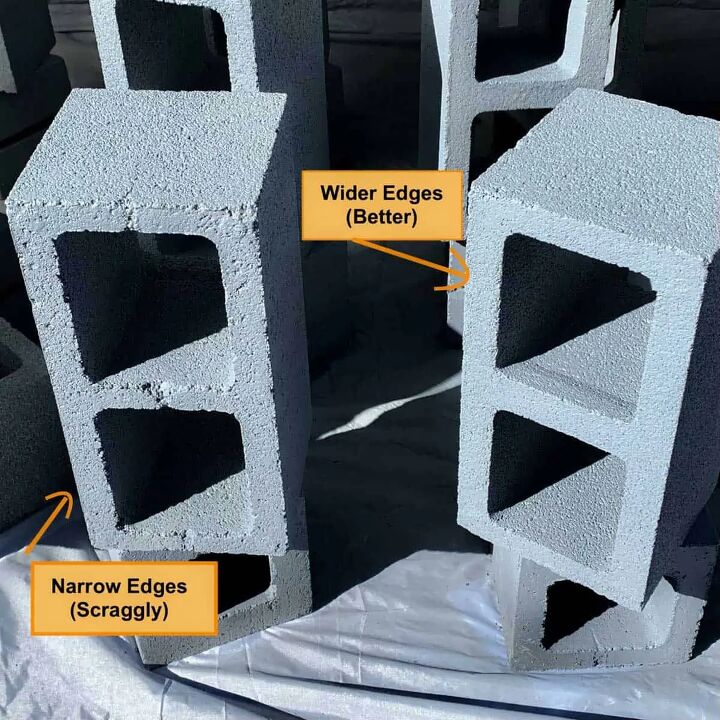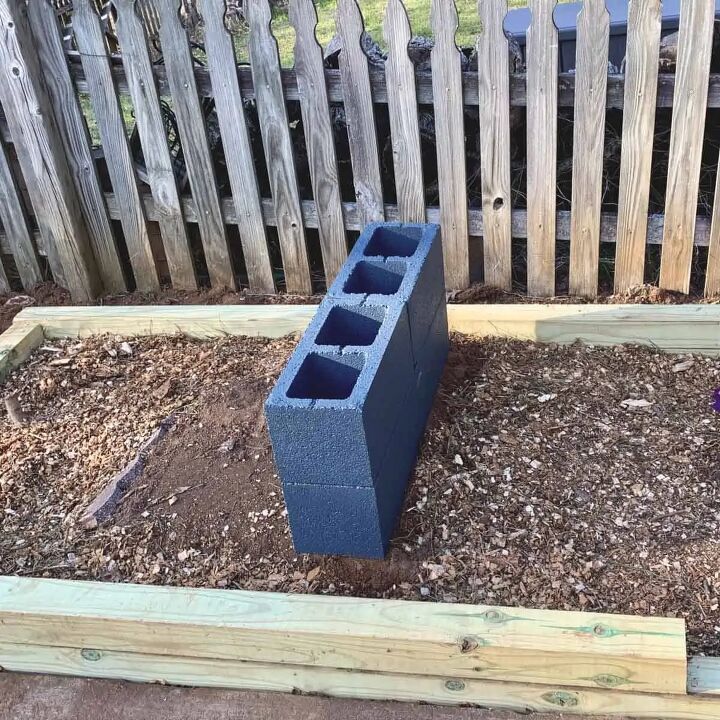
I’m rating this a moderate difficulty due to the physicality. The cinder blocks weigh 35lbs each. And during the cleaning, priming and painting steps, you are working with them on the ground.
This makes it difficult to lift with your legs. After all, you don’t have much leverage because you are bending more than lifting and moving, which means you will be working your lower back muscles a lot.
It actually gets easier when you assemble the bench, where you can use your legs to do the lifting.

Materials Note:
- You don’t need pressure-treated wood unless you aren’t painting the cinder blocks. You will need pressure-treated 4x4s if you don’t paint the blocks, to help delay rotting. I used kiln-dried Douglas fir.
- If you are painting them, pressure-treated isn’t necessary since they are going to be in contact with the ground or constant moisture and could take weeks to dry out enough to be ready for staining.
- Also, you don’t need a sprayer. A sprayer saves time, but also wastes paint. You can use a roller or brush. I have found that the combination of both helps- you’ll need the brush to get inside the holes.
- Just in case you have a very specific space you need to accommodate for a standard cinder block is listed at 16x8x8, but will actually measure 15 ⅝” x 7 ⅝” x 7 ⅝”. The interior holes are a minimum of 5×5” and your 4×4’s will be about 3 ½”x 3 ½”.
- For cleaning, a power washer is ideal, but if you don’t have one, just use a bucket and nylon scrub brush.
- Standard cinder blocks are made to be stacked horizontally. Each side is a little different around the hole openings.
- One side has longer holes and thinner edges and the other side has shorter openings and thicker, cleaner edges. I consider this to be the better looking side.
- Aesthetically you’ll want to note this when assembling the bench, and I will reference these edges in the steps below.

Timing:
Ideally, you’ll need 3-4 continuous days without rain if you are doing this outside. It can be done in three days, but you’ll have to stay on top of your timing.
You’ll need to figure in drying times after washing the blocks, then priming, flipping the blocks, painting, flipping and then repeating for one more coat.
Why Paint The Cinder Blocks?
The reason you should paint the cinder blocks is that it will help preserve the wood posts. By painting the blocks, you are waterproofing them.
If they aren’t painted, they are absorbing water, so the wood will be sitting in holes that are constantly wet when it rains.
Even though the posts will be stained and coated with urethane, they will be much more likely to rot. Painted cinder blocks will dry much more quickly and wick away much of the water.
How to Make a Cinder Block Bench Step by Step Tutorial
Step 1. Wash The Cinder Blocks

Place the cinder blocks on top of something so that they aren’t sitting on the ground. That way they don’t end up sitting in their own dirt and can dry more quickly.
I had square cinder blocks leftover from another project that I used to raise them.
Add TSP to the soap canister in the power washer, or fill a 2 gallon bucket with water and ¼ cup of TSP and wash down the blocks, if hand washing, use the scrub brush to help remove dirt and oil.
Let these dry in the sun at least a day, and flip them at least once. The blocks must be completely dry before you paint them or the paint will peel.
It may take more than a day to dry, especially if it’s not sunny. Wind will help.
You may notice in the photo that there are also concrete blocks, if you missed it in the intro above, those are for the upcoming planter box add-ons.
Step 2. Prime And Paint The Blocks

Spray a coat of primer onto the blocks. Make sure to thoroughly coat the cinder blocks so the pores are filled, also don’t forget to get inside the holes.

Check the manufacturer’s label on recoat times, but you should be able to flip the blocks after an hour and your time to recoat is probably going to be approximately 4 hours under ideal conditions.
If after 4 hours, the blocks feel dry and are not tacky, then go ahead and apply the first coat of paint.
Alternatively, if you don’t have a paint sprayer, use a paint brush to prime and paint the blocks.
If you are using the same acrylic exterior paint as I have recommended in the materials list, then your time to recoat is approximately 4 hours.
So if the paint feels dry and isn’t tacky after 4 hours, you can apply your second coat of paint. You may need three coats.
If you see any lighter spots still coming through, then go ahead and apply a third.
Step 3. Sand And Stain The 4x4s

First sand all of the 4×4’s using an orbital sander and 220 grit paper, and then wipe them down with a lint-free cloth.

Next, use a paint brush to apply the wood conditioner, be sure to wipe away any excess. Let the conditioner sit for 15-30 minutes.
If you feel any raised areas, then go over them by hand with grit sandpaper.
To give you a sense of time, I was able to cover one side of all 6 boards, setting a time for 15 minutes halfway through, with about 10 minutes remaining.

Now apply the wood stain with a brush. Be sure to wipe the stain down with a rag after a few minutes, so take care to not apply too much at a time.
I was able to cover one side of a 4×4 at a time, then wiped it down before moving on to the next. When all 6 were done, I flipped each and repeated the process.
If it’s your first time staining, or you need a refresher, here’s an excellent, fairly quick YouTube video on how to stain wood.
Once the stain is completely dry –at a very minimum of 2 hours (check the label), seal it with a clear water-based exterior urethane.
Step 4. Lay Out The Foundation For The Concrete Block Bench

Lay the first 4 blocks at the distance you want the length of the bench seat, 2 stacked on each side. The holes will be open at the ground and facing you when looking down.
For the placement distance, I had my bench base just under 77” from the left base leg to the right (inside to inside).
This measurement left a 3” overhang of the posts on each side when it was done.
The 3” overhang was planned at that measurement because of how I wanted the planter box add-ons coming up in part two of this series.
As mentioned in the materials note, when looking top down at the holes, each cinder block has one side with narrower holes and wider edges around them (the nicer looking side).
And the other side has wider holes with narrower edges (a little scraggly-looking). Be sure to lay the blocks so that the wider side is facing up. This gives you more gluing surface.

Now take the construction adhesive and run a bead of glue around the edges.
Take care to place the glue a little closer to the inside because the glue may spill over the outside and be visible if you put the bead right in the middle.
Repeat on the other side.

Next, add two more blocks on top of the glued bottom blocks, on both the left and right side.
Again, be sure to place the wider side on top of the glue since it has more surface. The skinner side will be facing you.
Step 5. Secure The Seating Blocks To The Base

First, make sure that everything lines up before gluing the side-facing seating blocks to the base.
Take the four side-facing blocks and place them on each side of the base (holes facing sideways).
Get four of the 4x4s and set them in the holes to make sure the bench seating lines up straight and is level.
If everything looks good, then go ahead and glue the seat blocks to the base. Otherwise, adjust them first before gluing them.

When gluing these, do the same as in the previous step, but this time you can apply the glue to the narrow edges.
This is because the seating blocks above are laying on their sides so you have the entire surface for the glue to adhere to.
Also, be sure to have the wider, better-looking hole edges facing out, the narrow edges will face inward. This also becomes a nice little arm rest.
Step 6. Glue The Back Support Cinder Blocks To The Seating Blocks

Add glue at the back of the block at the back and then place a block sitting in a vertical position.
Don’t put any glue past the middle point, stay within the end of the hole.

Alternatively, you can just apply the glue to the end of the back support block if you aren’t sure where the glue should go. Now just place the block vertically on top.
Step 7. Assemble The Cinder Block Bench Seating And Back Posts
Be sure to let the glue dry enough to get tacky before placing the posts into the holes, 10-15 minutes should be fine.
First, consider which side of the posts you want facing up since some sides of the post look nicer than others, depending on the grain and knots. Just gently insert each into the holes, leaving equal spacing on each end.
Wait 24 hours before testing out the bench seating. The reason for this is that the glue hasn’t cured yet and your blocks may slide out of place while the glue is still wet under the added weight.
Feel free to add seat cushions and decorative pillows for extra comfort and ambience to your super sweet cinder block bench!







